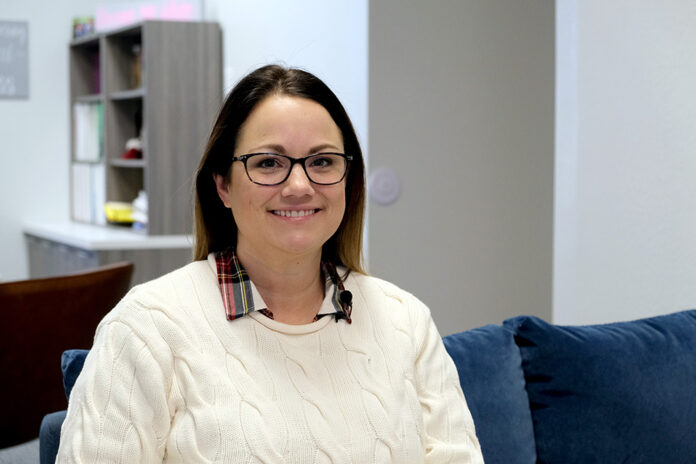
Jill Broussard grew up in Ohio two towns away from Pinal County Attorney Kent Volkmer and now works out of a former grocery store that is the Florence offices of the county superintendent of public education. She sat down to talk with InMaricopa about working with Pinal County’s 19 school districts, the Legislature and test scores.
[quote_box_right]Jill Broussard
Title: Pinal County superintendent of public education
Age: 41
Hometown: Westerville, Ohio
Residence: San Tan Valley
Pinal County resident since: 2004
Family: Husband Dan and two teenage sons
Education: Bachelor’s degree in elementary education and teaching from Arizona State University; master’s degree in educational leadership and administration from Northern Arizona University
Politics: Elected to current post as a Republican 2012, reelected 2016, seeking reelection 2020
Previous work: Taught sixth grade and kindergarten
Worst-kept secret: Has fostered dogs for Great Dane Rescue Alliance of Arizona[/quote_box_right]Please remind us of your background.
I came to Pinal County in 2004 and we moved to San Tan Valley. I had taught for a couple of years. My husband joined the Arizona Army National Guard, and I decided to stay home with the kids since we weren’t really sure what his schedule was going to look like. After staying home for a couple of years, I was speaking with some other community members, and they encouraged me to run for county school superintendent. I had no idea what I was getting myself into.
Were there issues that caused you to run?
I just have always wanted to do. I’m a doer. So, if I can do something to help improve education in Pinal County, and having a horse in the game with my two boys being in education in Pinal County, I just was motivated to start thinking outside the box and doing things a little differently.
What is a typical week in the life of the superintendent?
A typical week is really all over the board. I don’t even have a typical day. In order to explain that, let me tell you what our duties are as county superintendent. It’s laid out in state statute. We are in charge of the fiscal services for the 19 districts here in Pinal County. We help them with balancing to the treasurer, the distribution of federal grants, state grants, and their checks are printed through our office. Then we also do professional development for all of the teachers and staff. We work really closely with the superintendents, the principals and the teachers as far as identifying what areas they need support in. But we also, through our Education Service Agency that does professional development, we also help with different consortium. So, anything that we can help with maybe banding together and getting lower rates, lower costs on somethings just to help them save money. I also do the juvenile detention center and the education at the jail. We also do a GED program at the jail. We have an accommodation district, Mary C. O’Brien Accommodation District; it’s down off 11 Mile Corner near Casa Grande, the elementary is. And we have a high school that is down in Toltec, and it’s an alternative high school. We top out at 125 students. Both of those schools provide a specific education that maybe no other school in the county can provide.
[pull_quote_center]There’s a local charter school that requires their parents to volunteer 40 hours a year in the classroom or for the teachers. We can’t do that as public schools. [/pull_quote_center]
What is an accommodation school?
Historically, it began as an unincorporated area outside the boundaries of any other district. It was mostly farmland, and it would swell with migrant workers at certain times of year. Well, their kids need to be educated, so that fell under the county school superintendent’s responsibilities. Then for a number of years it became a special-education school and program. Then the districts started to take their special-ed kids back, which is a great thing, and we opened it up as a regular elementary school. Now under the direction of my associate superintendent and the principal over there, they’ve done great things with the staff and they are getting some of the top scores in the county and the state.
Why do you think that is?
It helps that they’re a small school and the teachers are very skilled. We have very little turnover there. Really when somebody retires, that’s when we have turnover there. We have one teacher per grade level. Some of the classes are pretty small because, like I said, we top at 125. We usually leave a couple of spots open because if anybody moves into the district, we don’t want to go over that number. They just really developed some great programs, reading programs where the whole class goes into reading lab, small groups, one-on-one, and now we’re doing the same thing with math instruction. Just having that personalized instruction and that ability to do that small-group work really goes a long way.
What are successes you’ve had in office so far?
When I first came in, we worked really hard with the juvenile detention facility to revamp that program over there and really work in some transition skills so those students have some skills that really apply to real life when they get out. Yes, we’re working on getting them credits and catching up. We’re trying to get them graduated from high school, but we’re also teaching them how to budget, how to interview, how to research and investigate different avenues they can take when they get back out on their feet.
Another one, we had Justice Sandra Day O’Connor come, and she spoke to our superintendents and students about her iCivics program. That was just really fun, and to be able to get your picture with an icon like that and have her come and speak to our kids and inspire them was really amazing.
[pull_quote_center]We had a number of counties that had to close their juvenile detention facilities because you have to provide an education and they didn’t have enough money to pay teachers and staff to keep those doors open.[/pull_quote_center]
We have a business and education partnership that we started with Pinal Partnership. We do a summit every year and we highlight different programs that are happening between businesses and schools in the communities as well as different things we need to focus on as a community. So, Center for the Future of Arizona has the progress meters. We’re working on progress meters here in Pinal County as well with a committee and when we bring those up when we have our summit, we’re able to address those issues with the rest of the community and say, ‘Here’s where we are and here are the things that we’re doing to help improve those numbers.” I’ve also worked on some legislation with our Arizona Association of County School Superintendents and gotten some legislation through. Most recently was the funding for our juvenile detention facilities. The funding levels for the juvenile detention facilities, for the education in there, was very low. We had a number of counties that had to close their juvenile detention facilities because you have to provide an education and they didn’t have enough money to pay teachers and staff to keep those doors open. We had five other counties begin sending their students to our facility here in Pinal County. That was Apache, Navajo, Graham, Greenlee and Gila. We still just had a principal/teacher, a paraprofessional and an administrative assistant running that with all those counties sending their students. What we did was we ran legislation to increase funding from $25,000 a year to $100,000 a year, which will pay for an additional teacher for us, and instead of $15 a day, $25 a day. A good majority of those students are pretty far behind academically and have some other issues that they may be dealing with, either emotionally or academically, and they need that additional support. It is pretty costly to educate those students. So, with that, we’ve been able to hire a couple more teachers and have a really great, strong program happening there.
What are some things you’re struggling with?
One of the things I do struggle with actually in this position is really I don’t have the authority over the districts. I’m not saying I need authority over the districts. It’s just when I see a great program working somewhere else and I would love to see it in our districts here, it can’t always be done. They may have something else in place; they may just have a different vision than I do. But what really kind of haunts me, and it’s a question that’s asked me all the time, is how do we get our parents involved and engaged in our students’ education because that makes the largest impact on a student’s success. Knowing that Mom and Dad are supporting them, knowing that Mom and Dad find value in education and so they need to be doing their best and being encouraged and helped goes a long way. How I do that from the county position of county school superintendent, I haven’t figured that out yet. That’s something where I lay awake and try to think of ways to do it. But there are 19 districts, so what’s going to work in San Tan Valley may not necessarily work in San Manuel. We have such a wide variety of schools and situation in Pinal County.
There’s a local charter school that requires their parents to volunteer 40 hours a year in the classroom or for the teachers. We can’t do that as public schools. We take whatever students come; we take all their baggage with them and that’s not necessarily the case with charter schools.
What is your relationship with the Legislature?
Over the years, that’s been a focus, and I’ve gotten a little better each year. I really do feel like I am in a position where I can advocate for the districts of Pinal County. Because I’m not necessarily on a campus every day like our other superintendents are for our districts, I feel like I can be their voice up at the state Legislature. I also go once a year to D.C. and I meet with our congressmen and -women up there. I talk to them about what’s happening in rural Arizona. And I have developed those relationships over the years. It’s really nice because sometimes I get emails that their reaching out to me for information from our districts whereas I was just constantly feeling like I was knocking on their door, making requests of them. But they’re listening, and I’m seeing that.
When you talk about having resources for fiscal management, what do you have available for the schools if they’re having issues that way?
For fiscal management, that’s this office here in Florence. We have our accountants, and whenever there’s questions from the districts, they’ll ask our accountants, and we will do research for them on whatever their fiscal services questions are, payroll, withholdings, even funding. We’ve had a couple of times when business managers have either left unexpectedly or been ill, and I have accountants that will fill in for them temporarily until they find a replacement. We’ve helped with some training of some new business managers as well.
[pull_quote_center]Where I’ve seen the most success for districts is when they get out into the community and they really discuss the needs and the reasoning behind going out for a bond and override. [/pull_quote_center]
Across the state, lots of schools had bond issues and overrides on the ballots. Many of them did very well; Pinal County really struggled. What was your reaction to that, and do you have any advice for them in the future?
Historically, the bonds and overrides, when I first came into office, they weren’t passing then either. Then we had a little stretch where we had some good passage and support. This time was not as great. It is a little disappointing to see, coming from a state where anytime a bond or override came onto the ballot it was just the culture to just say yes to whatever. I think our voters here are a little more discerning, maybe a little more concerned about how the money is spent. Where I’ve seen the most success for districts is when they get out into the community and they really discuss the needs and the reasoning behind going out for a bond and override. So when you get out into the community and you say, “Look, this is to build a new gym because the other one’s full of asbestos and mold. We have a bus fleet of six buses, and three of them are broken down and two of them are on their last legs and these buses cost over $200,000 and that’s not money we have in our coffers right now. We can’t fund another four buses at the moment.” Technology is a huge one. We have an eRate consortium, and we’ve received a grant for $33 million to do a broadband initiative in the county. We’re bringing broadband to every school and every library in the county. Suddenly, these schools that were a little more remote, maybe, and didn’t have access to that fiber cable, now they do and now they can bring that technology into the school. And that’s a huge cost as well. Every district is going out for their bond and their override for different reasons, but I’ve seen the most success when they go out and they communicate with the public on that.
How long did it take you, moving here from Ohio, to get up to speed on how things operated in the education differently?
I went to school at ASU, so I was educated here, but I really had to get into the system to really see that there’s a difference. We don’t have as enormous of a retirement population as in Arizona. There’s some wonderful things that come with having a huge retirement population here in Arizona. And there’s some not-so-great ones, like, “I don’t have any kids in the school system, so why should I pay for your kids to go through?” I have a great argument for that – somebody paid for their kids and paid for them to go to school – but as far as getting up to date I was definitely in this office before I really had a good grasp on what it looked like here in Arizona. It’s huge. It’s vast. I’m learning something new everyday in this position. I even went back to school once I got this position for my master’s in educational leadership because I really thought that would help me understand more and also lead an organization. It’s intricate, especially school finance. That’s a tough one. I will be a lifelong learner of school finance. I will never know everything there is to know about school finance, but I learn more every day.
[pull_quote_center]And a note to anybody who applies – if you don’t mention kids in your interview, you really don’t have a chance of getting appointed to a school board. But it happens all the time.[/pull_quote_center]
One of the “fun” things you get to do is, when there is an opening on a school board or the college board, you get to make that selection. What is your thought process?
Pinal County’s the size of Connecticut. I can’t know the inner workings of every community. And we all know that there’s some inner workings in every community and history that’s there. So, typically I reach out to the superintendent and let them know that I will take up to two recommendations from the board once we get all of the applicants. I interview all of the applicants. I listen to them. I make a selection based on what that board needs. A recommendation from the board goes a long way. When I do the CAC governing board, I tend to form an interview committee or panel. I try to make sure I have, I may possibly have an elected official, I’ve had one or two employees of CAC, I try to have community members, business members. I try to represent many facets of the population in that area. And then I have them help me with the interviews. That ones a tough one because it affects the tax rate for the entire county. I think it’s important to have that input. I haven’t been as lucky with getting panels together for some of our districts just because it’s a smaller community and sometimes difficult to get… without bias, someone open-minded. That’s why I think talking to the superintendent, talking to the school board, really helps me get a view of what the district needs, what the school board needs, and then I try to put somebody in there.
And a note to anybody who applies – if you don’t mention kids in your interview, you really don’t have a chance of getting appointed to a school board. But it happens all the time.
What would you like to see happen with public education in this county?
Well, test scores are not everything, but it is a good indicator as to how our students are performing with other students around the state and even in the country. So, we really want to help promote mastery in teaching when it comes to ELA and math. That’s huge. But I think another huge thing is preparing our students for the jobs and industries that are coming to our county. Looking ahead at what skills they’re going to need for that and that they can be adaptable because they’re probably not going to wind up in a job that they’re going to sit in for 40 years. We’ve seen that trend happening for a few years now. We have these great industries coming to Pinal County and wonderful opportunities. So, to be able to set them up with more career and technical education and even starting at a younger age would be great – having those options open to them, internships. It’s hard for me to narrow it down because the sky’s the limit when it comes to our kids. I’m on the State Board of Education, and getting to hear and see some of the innovative things that are happening across the state is really exciting. I’m on the executive council of a national organization called Association of Education Services Agencies. I get to see what’s happening across the United States. That is really exciting because I can bring that back to our school here in Arizona. Rural Arizona can have those same opportunities that are happening in Chicago, Illinois, and that’s exciting. Just providing the same quality of education in rural Arizona that some of the big cities and affluent neighborhoods are getting is exciting for me, and I want to continue to bring that to the doors of our students.
This story appears in the February issue of InMaricopa.




![Alleged car thief released without charges Phoenix police stop a stolen vehicle on April 20, 2024. [Facebook]](https://www.inmaricopa.com/wp-content/uploads/2024/04/IMG_5040-218x150.jpg)
![Locals find zen with Earth Day drum circle Lizz Fiedorczyk instructs a drum circle at Maricopa Community Center April 22, 2024. [Brian Petersheim Jr.]](https://www.inmaricopa.com/wp-content/uploads/2024/04/PJ_3922-Enhanced-NR-218x150.jpg)


![Who’s the Best Mom InMaricopa? Nominate now! Marlene Marshall, Christina Olivares, and Meghan Bremer. [Bryan Mordt]](https://www.inmaricopa.com/wp-content/uploads/2023/05/BCM_8465-218x150.jpg)







![Alleged car thief released without charges Phoenix police stop a stolen vehicle on April 20, 2024. [Facebook]](https://www.inmaricopa.com/wp-content/uploads/2024/04/IMG_5040-100x70.jpg)